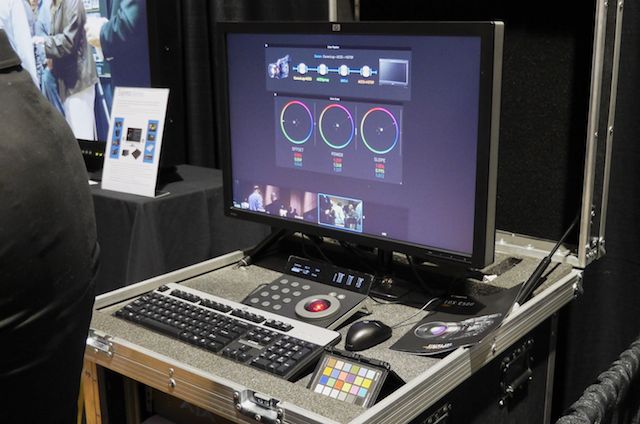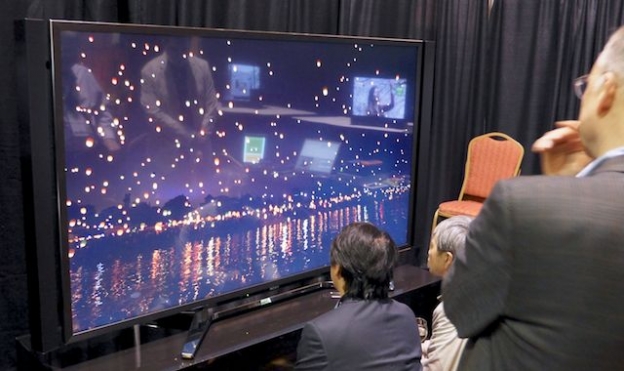The 2013 HPA Tech Retreat has concluded. In my final report, I offer some observations, look at a few items in the Demo Room, and show Mark Schubin’s post-retreat treat.
Observations and Comments
4K and the cloud were in, 3D was out.
Sony has apparently had F55 4K cameras in the field for several month, as we heard on Day 1. There was one in the demo room, too, but deliveries to civilian customers are just beginning. 4K in production, post, and delivery are all active topics now to a greater extent than ever before… as are high frame rates and high dynamic range images.
The cloud, file-based workflows, remote / on-set post, interconnectivity, bits taking precedence over atoms: in a way, the digital transition (in production and post as well as delivery) is just now reaching its full expression. Content (“something you can stick in your eye”) is being liberated from the tyranny of physical media (“something you can drop on your foot”) to the extent that it's not really news any more; it's just an accepted workflow.
3D is dead? Some might argue, “it's just resting“, but as Pete Putman reported at his breakfast roundtable, the CE manufacturers are saying, “we've moved on”. Yes, all the larger sets have 3D capability built in (as well as “smart TV” functions that also go unused by the vast majority of consumers), but between the lack of content, mismarketing (by the CE vendors) and overpricing (by the theaters), and the less-than-ideal viewing conditions (your choice of annoying glasses, or low-res and positionally-dependent autostereoscopic displays), 3D is rapidly fading into the background. Maybe next time, around 2035, 3D will be here to stay, but it just hasn't achieved critical mass in this most recent 25-year cycle.
Some of the session notes I took are cryptic and fragmentary to the point of opacity. That's not entirely my fault; some of the presentations were unusually arcane and hermetic. There's always a danger when you get deeply-involved geeks to speak (and I say that with highest respect) that they will talk geek-speak that's only comprehensible to their immediate peers. A few of the hardware-implementation presentations were like that; despite my own chip-level embedded systems work (20+ years ago!), I found it hard to follow their presos.
Other times, the presenters simply spoke at such rapid rates (and changed slides with such alacrity) that I simply wasn't able to keep up with my fumble-fingered typing. Heck, sometimes I didn't even have time to frame, focus, and photograph a graphic before it was replaced with another. Apologies.
Both the arcane techspeak and the rapid-fire delivery are simply hazards one has to expect at the Tech Retreat, a.k.a. The Engineer's Picnic. When you get many of the best and brightest in the business together in a conference like this, it's like drinking from a fire hose.
That's why my notes are only a faint shadow of the on-site experience. Sorry, but you really do have to be there for the full experience. The HPA will probably request proposals for the 2014 presentations in September, and open registration for attendance in November or December; stay tuned to http://www.hpaonline.com for details.
A Brief and Incomplete Look at the Demo Room
The Demo Room is where vendors show off cutting-edge tools and design concepts, often (though not always) things that haven't been seen elsewhere. I didn't survey the room in depth this year; instead, I provide a highly selective (and therefore terribly unfair) glimpse of just some of the things on offer.
“Post on demand” was one of the panel discussions, and at least three vendors brought portable editing / grading systems to show:

ColorFront's portable grading system.
One of Bling's P.O.D. portable systems.
MTI Film's Control Dailies portable system.
4K was another hot topic. Sony had a middling-large screen (by 4K standards) on show, while Panasonic had what may be the smallest 4K screen around…
Sony's 84-inch 4K screen.
Sony's 84-inch 4K screen.
Note that the best way to truly experience 4K on a middling-large screen like this is with your nose almost pressed to the glass. Lechner distance? We don't need no steenking Lechner distance!
Panasonic's 20-inch 4K panel.
Behind the scenes with Panasonic's 20-inch 4K panel.
This was “one of eight panels in existence” and two were at the Tech Retreat: this one, and one built into a Windows 8 tablet, albeit a tablet large enough to serve as a dinner tray (brings new meaning to the term, “TV Dinner”?).
Optical Vaults' disc library.
Back to the future? In this pre-NAB preview, startup company Optical Vaults showed an archiving system consisting of Bly-ray transports fed by robotic disc changers. There are two sets of readers/writers at the back of this box, with two pull-out disc caddies (here, each has only one disc in it) with the disc-changing robot running between 'em. Optical Vaults claims 1% of the power consumption of disk arrays, and a 50+ year life at 10^-24 bit error rate. 40 TB in 4RU; 320 TB in a 6-foot rack, and “unlimited offline storage of 25 TB per cubic foot”.
OmniTek OTR 1001 front panel.
In a menu- and mouse-driven world, at least OmniTek understands the value of physical buttons!
Barco's Auro 11.1 immersive sound mixing UI.
Auro is Barco's immersive sound system (Dolby's Atmos system was discussed in the “Immersive Sound” session).
1Beyond's Thundertape and Mac Wrangler.
1Beyond's portable data-wranging systems have been around for a while, but at the Tech Retreat they showed a Wrangler running OS X instead of Windows, making Mac-based D.I.T.s very happy. They also had “Thundertape”, a Thunderbolt-connected LTO tape drive, and a complete portable asset management system using Axle software on an OS X server.
Lightcraft's Previzion blurb. #3 is the most cool of the new stuff.
Lightcraft's Prevision system has also been around for a while, but it keeps on getting better. Their photogrammetry scene-reconstruction system looked very, very good, and promises to make the capture and importation of real-world scenes into the CGI domain rather a bit easier. [Disclosure: the studio I used to work for bought a Previzion a few years ago and I spent a fair amount of time driving it, so I might be overly predisposed to look favorably on it… even so, it's pretty neat!]
Next: Watching Remote Baseball Games Live Before Television (Really!)
Post-Retreat Treat: Watching Remote Baseball Games Live Before Television (Really!)
Mark Schubin, SchubinCafe.com
Mark always adds a bonus session of historical interest following the official retreat. This year Mark reprised his September 2012 discussion of remote baseball viewing before television (http://www.schubincafe.com/2012/09/26/watching-remote-baseball-games-before-tv/), only with more illustrations. Look at these slides as accompaniment for that article (for best results, pop that link up in a new window, and you can view these pix as you read Mark's article).
…and then in 1939, televised baseball started.
Screenshots, graphics, and UIs are copyrighted by their owners. Some have been cropped / enhanced to improve readability at 640-pixel width.
Disclaimer: I attended the Tech Retreat on a press pass, but aside from that I paid my own way (hotel, travel, food).


